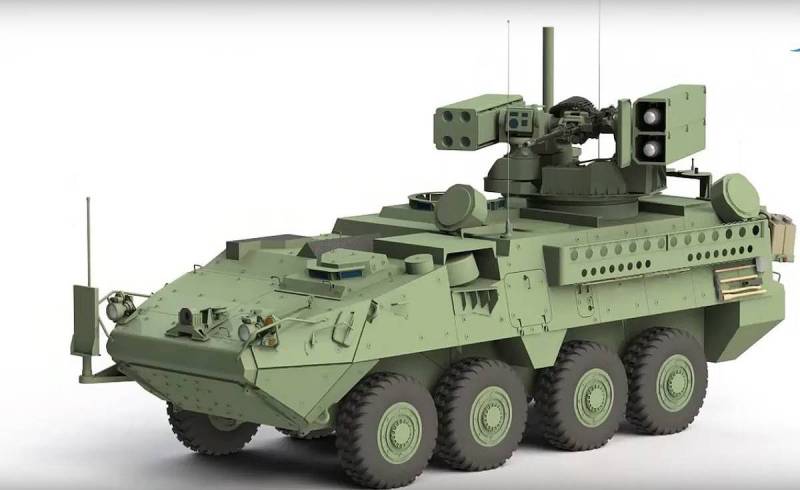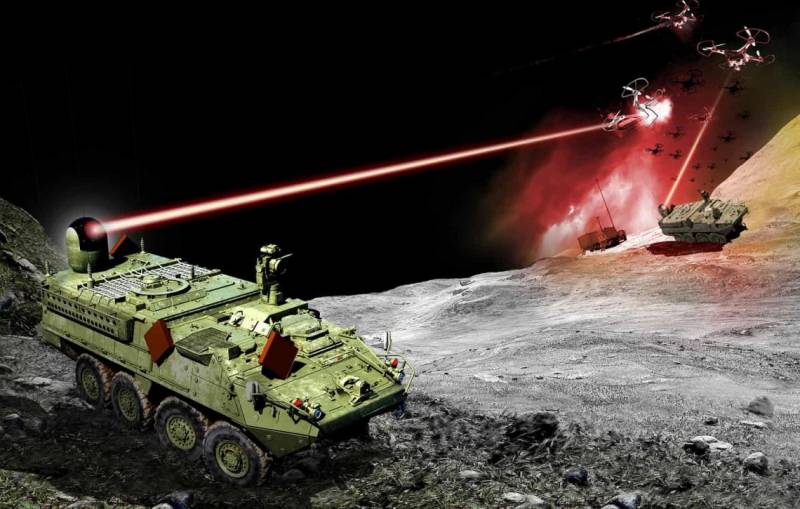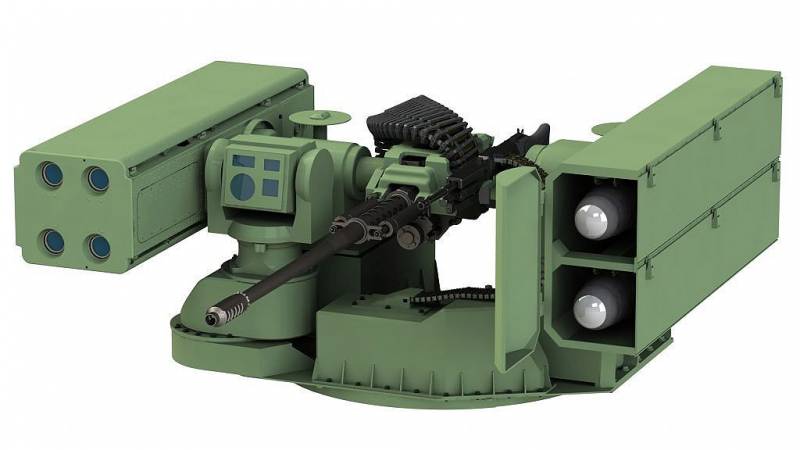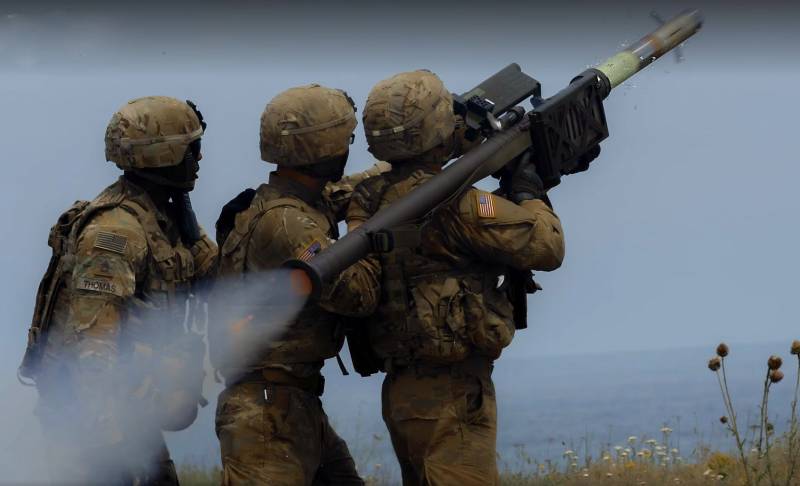After the Cold War, the US is forced to build up its air defense forces

IMSHORAD short-range self-propelled air defense system is one of those urgent projects in which ground forces will receive full-time capabilities to protect against air threats
Having determined the shortage of staffing capabilities of near-air defense, the US army began an urgent assessment and purchase of new missiles, lasers, sensors, and much more.
The U.S. Army is preparing a major reorganization of the system to protect its ground units from near airborne threats, and therefore in October 2019 introduced a new version of the Stryker armored vehicle, optimized to combat aviation, and also recently signed a contract with Israel for two batteries of Iron Dome complexes for deployment in 2020 as a temporary means of missile defense (ABM).
These activities, along with the planned urgent modernization of Sentinel radars, the deployment of new AIM-92 Stinger missiles with a remote fuse and a new passive long-range surveillance radar, are part of large-scale efforts aimed at combating the growing threat of air and missile attack systems, which can pose a serious danger to US Army.
“We see the widespread use of unmanned aerial vehicles performing reconnaissance and target designation,” said Chuck Washim, spokesman for the Redstone and Space Programs at the Redstone Arsenal. “We also see that some of our opponents are increasing funding for developments in the field of cruise missile technology.”
Fall and fall
In 2016, the National Commission for the Prospects of the Army concluded that there was an acute shortage of short-range air defense systems in the troops, since after the fall of the Berlin Wall, the army seriously reduced its staffing capabilities, retaining only a couple of regular divisions of short-range self-propelled anti-aircraft missile systems (SAM) Avenger. Seven Avenger units remain in the National Guard, where they perform primarily national security tasks.
“After the Cold War, the army assessed the threat of the air force of a potential adversary as small,” the Congress commission report said in 2016. - The military activity of recent years in Syria and Ukraine has shown a change in the nature of threats. However, in the regular army there was not a single battalion with short-range air defense systems. In addition, most of the National Guard’s near-air defense assets carry out important duties to protect the metropolitan region, and therefore other contingents in different parts of the world got very little, including areas with real threats in North-East and Southeast Asia, Eastern Europe or the Baltic countries. "
The U.S. Army subsequently upgraded two Avenger divisions — 72 systems based on the HMMWV armored car chassis with mounted air-to-air missile launchers — and deployed two regular divisions in Germany as part of the European containment initiative. The army also launched a campaign to restore its means of near air defense, identifying several priority areas.
In the summer of 2019, the first IM-SHORAD weapon system was manufactured, which included: the AGM-114 Hellfire missile launcher, the SVUL (Stinger Vehicle Universal Launcher) vertical launcher of the AIM-92 Stinger missiles, a 30-mm gun and an optoelectronic station . This new weapon system was then delivered to a Michigan plant for installation on a Stryker armored vehicle and preparation of the IM-SHORAD air defense system for AUSA 2019.
In October 2019, at the AUSA exhibition in Washington, the army presented the first machine equipped with IM-SHORAD standard (Initial Maneuver-SHORAD - initial maneuver-close air defense) - a new version of self-propelled air defense systems based on the Stryker platform mentioned above. The US Army thereby demonstrated a new accelerated process of creating models of military equipment capable of withstanding the challenges of potential opponents, in particular the Russian threat to the American contingent in Europe.
Just about a year and a half ago, the U.S. Army, following an unconventional path for the purchase of military equipment, entered into agreements on the IM-SHORAD complex with Raytheon for the supply of the SVUL, with Leonardo DRS for the delivery of the rotating combat module and with General Dynamics Land Systems for the integration of the system.
“It's amazing how fast we were moving. We issued the contracts in September 2018 and literally 13 months later we had a fully equipped car, which was shown at the AUSA exhibition in October 2019, ”said Washim. - From issuing a contract to a real car at the AUSA stand. High rates, great work, close cooperation of the three partners. ”
None of the three companies is the main contractor or subcontractor of the IM-SHORAD complex. “It took a complete calculation of the whole team to get the final product.”

Last summer, the U.S. Army selected Northrop Grumman and Raytheon to develop prototypes of laser systems. weapons and installing them in 2023 on a Stryker machine
Prototype Progress
The new version of the Stryker platform is designed to work on air threats from any direction, including helicopters and aircraft at ranges up to 8 km and unmanned vehicles at ranges up to 6 km
Military trials of the first nine IM-SHORAD experimental complexes have been underway since last October, they will last 6-7 months and based on their results, a decision will be made to begin the planned production of 144 vehicles. The army intends to deploy two divisions of 36 IM-SHORAD complexes each by 2021, and then a second pair of divisions of 36 new mobile air defense systems on the Stryker chassis by 2022.
The IM-SHORAD program became fully operational in September 2017, when a demonstration of the capabilities of a short-range air defense system offered by a contractor was held at the White Sands training ground in New Mexico. “It was nothing more than a proposal to the industry:“ Hey, we have a problem that needs to be addressed. ” Let's go out to the White Sands and show us what you have. Under your responsibility. And we will provide a training ground and help you with a set of goals, ”said Washim.
Russia's actions in Ukraine forced the American army to take a decision to strengthen and build up its air defense systems to protect the heavy armored brigades and Stryker brigades in Europe. The results of these tests in New Mexico helped the army clarify what it wants in the characteristics of IM-SHORAD, which was noted in the 11-page memorandum issued by the General Staff.
“The recent aggression against Ukraine significantly complicates the situation regarding security and stability in Europe and all NATO allies,” warns the chief of the General Staff in this memorandum, which also sets out to purchase 144 cars. - The ability of European countries to quickly create effective military formations is a serious problem for NATO. However, our reports indicate an accelerated modernization of these military forces by increasing mortality and combat stability. ”
The Army is currently evaluating rapid deployment units such as the Stryker 2nd Reconnaissance Regiment, with a view to enhancing their capabilities by expediting the purchase of such new air defense systems.
Seven months after their needs were approved, the army issued prototype contracts. Washim noted:
However, he hopes the IM-SHORAD will perform well during the test.
Laser circuits
Meanwhile, the army is refining its requirements for another new Mobile SHORAD (M-SHORAD) system, intending to release a document in March 2020. The document, among other things, proposes a specific constructive solution in order to more fully meet the needs of the army.
In the summer of 2019, the army took a non-standard approach, giving Northrop Grumman and Raytheon contracts for the development of competing prototypes of the first combat laser system.
In accordance with this project, in 2023, prototypes of 50 kW laser systems for a platoon of four Stryker machines should be supplied. Weapons of directed energy will give the M-SHORAD division new opportunities for the destruction of aircraft, helicopters, missiles, artillery and mortar shells.
“Now is the time to put them on the battlefield,” said Raytheon, project manager for directional energy weapons. - The army recognizes the need for laser weapons, which is necessary for its modernization. This is no longer research and development. This is a strategic combat capability, we are in the process of transferring these systems to the hands of soldiers. ”
Protection dome
The U.S. Army, in fulfillment of a Congress order to procure intermediate cruise missile defenses by September 2020, chose the Iron Dome missile defense system as its temporary system in 2018.
The army will purchase two Iron Dome batteries to provide the ground forces with temporary means of fighting cruise missiles, as well as drones, mines, missiles and shells. At the same time, she is studying the full-fledged deployment of the Israeli complex under the IFPC Inc 2 program (Indirect Fire Protection Capability Increment 2-Intercept) and its integration with the combat command system by 2023.
In October 2019, the army notified Congress of its decision to actually replace the AIM-2014X II guided missile, developed since 9, designed to launch from the IFPC Inc 2 Multi-Mission Launcher launcher with the Iron Dome complex, which includes the Tamir interceptor missile .
“Iron Dome is a good system,” said the Army Chief of Staff at the Senate hearings. - I went to Israel and saw demonstration launches. This is a very, very good system. This complex has a very good track record, it also showed itself well during various tests. ”
“I think now that we will be able to meet the deployment of facilities within these deadlines,” said Washim. - We see that the schedule is being maintained, the production of Iron Dome complexes is on schedule. We will receive the first battery of the Iron Dome complex in the fall of 2020, and the second in a couple of months. ”
In addition to urgent purchases, the army proposed a draft plan for the allocation of $ 1,6 billion by the end of 2024 to equip Iron Dome systems with IFPC Inc 2 launchers and missiles and integrate Sentinel radars and IBCS (Integrated Air and Missile Defense Battle Command System). The project to develop an integrated air defense and missile defense system IBCS is led by Northrop Grumman, and it is developing a common fire control component for it, which will monitor and coordinate the networked radars and missiles.

The IM-SHORAD complex is based on the Reconfgurable Integrated Weapons Platform Mission Equipment Package production module manufactured by Leonardo DRS
Joint efforts
In 2011, the US Congress allocated over $ 1,4 billion to Israel for the production of Iron Dome batteries from Rafael Advanced Defense Systems. In August of that year, Raytheon and Rafael, implementing a joint missile defense system development program based on David's Sling (David Sling), announced an agreement that would allow Raytheon to sell Iron Dome systems in the United States. Three years later, the governments of the two countries signed a joint production agreement that allows the production of some components of the Iron Dome complex in the United States, for example, anti-missile systems.
Rafael says the Iron Dome system is
The Iron Dome complex is designed to deal with various threats at ranges up to 70 km, as well as missiles launched from a distance of up to 10 km. The battery of the Iron Dome complex includes ELTA's multi-purpose radar station EL / M-2084, a fire control center and three launchers, each of which is equipped with 20 Tamir interceptor missiles.
The complex gained international fame after the fighting between Israel and the Hamas militants in 2012. According to the Pentagon, the Iron Dome complex intercepted 85% of the approximately 400 missiles launched from the West Bank in November of that year.
In early 2017, the U.S. Army began exploring ways to accelerate the deployment of an IFPC midterm solution. The 2018 Trump administration's national defense strategy notes the importance of the anti-missile defense that they have when defending against potential Chinese and Russian threats. The army then considered three options: Iron Dome, the Norwegian complex Norwegian Advanced Surface-to-Air Missile System (NASAMS) by Kongsberg and Raytheon and an improved version from the IFPC Inc 2 project.
Only the Iron Dome met the goal - deployment in 2020 - and at the same time cost less than NASAMS. According to the army, if the NASAMS launcher costs $ 12 million and each AIM-120 AMRAAM rocket costs $ 800 thousand, the Iron Dome launcher costs $ 1,37 million, the fire control center is $ 4 million, the radar is 34,7 million and each missile Tamir 150 thousand dollars.
The new interceptor option for the IFPC Inc 2 air defense project - the EMpan (Expanded Mission Area Missile) missile - will be selected from three competing projects: the Lockheed Miniature Hit-to-Kill Missile, Raytheon's Accelerated Improved Intercept Initiative, and SkyHunter. According to the army, all missile defense - candidates for the EMAM project - require qualification, integration and testing before production and their subsequent adoption in service in 2023.
The Army’s report notes that “with an eye to 2023, the army plans to explore the possibility of integrating a launcher and a missile defense for the IFPC project, which was the result of joint research and experiments by the army and the marine corps.”
Further development
Another component of the Army’s comprehensive project to strengthen near-air defense is the A4 Sentinel radar program. This upgrade program for nearly the current 200 Sentinel A3 radars is valued at $ 3 billion.
In addition, in June last year, the head of the US Army Aviation and Missile Administration approved an urgent request for remote fuses for Stinger missiles. The modernization of the rocket, developed by Raytheon, will be included in the program to increase the life of existing arsenals.
“Traditionally, a direct hit missile has been part of the Stinger weapons system,” said Washim. “She will retain these opportunities, but she will also have a remote fuse, which we will integrate with the new target detection system.” This will change a lot in the tactics of using such weapons, especially good in the fight against small UAVs, since they do not generate as much heat as we would like. Nevertheless, we can cope with this threat with a remote fuse and a new detection system in the Stinger complex. ”
Finally, in March 2019, the army unveiled a previously classified project called ALPS (Army Long-Range Persistent Surveillance - Long-Range Continuous Monitoring for the Army). This is a new passive sensory system, the deployment of which the US Army began in its contingents in Europe, the Pacific Ocean and the Middle East.
The deployment of this development system by the American company Dynetics began after the demonstration of the integration of ALPS into IBCS in 2018. “Prototypes will be delivered to meet the operational needs of the various combat commands and to conduct a subsequent evaluation there,” said the ALPS project manager. “The goals of this activity are to ensure the development of components and subsystems in real conditions and to reduce subsequent risks of integration.”
After full integration into the IBCS system, the ALPS mast sensor station will be able to provide long-distance circular surveillance of aircraft and helicopters, UAVs and cruise missiles.

Information